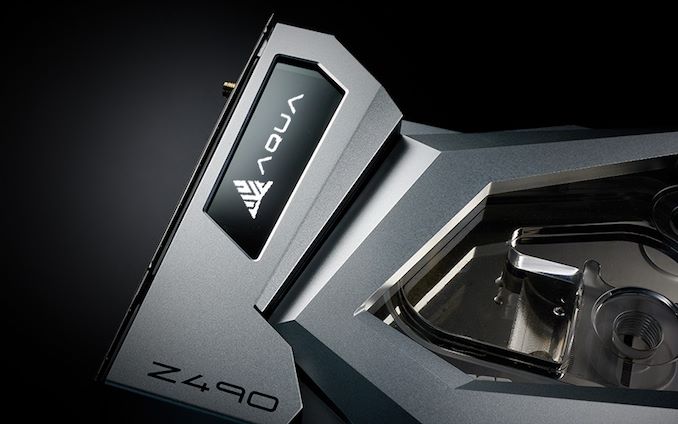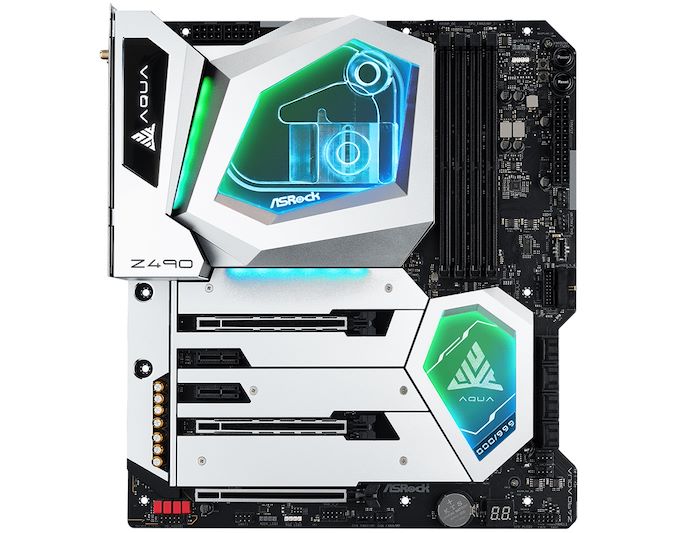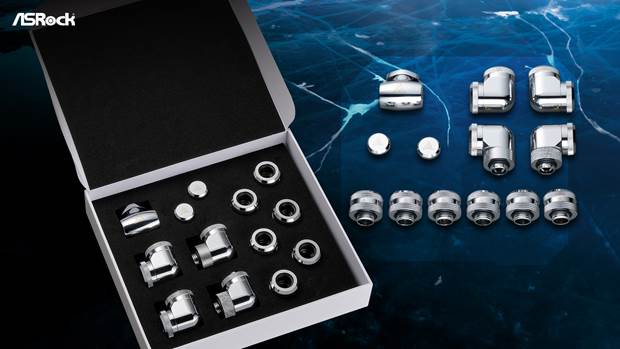The ASRock Z490 Aqua: Thunderbolt 3, PCIe 4.0 Ready, Water Cooled
by Gavin Bonshor on May 5, 2020 2:00 PM EST
Following a resurgence of motherboards decked out with custom monoblocks, ASRock has announced details on its Z490 Aqua. It includes a familiar aluminium plated copper custom monoblock, with just 999 units available for purchase. It includes two Thunderbolt 3 Type-C ports, three PCIe 3.0 x4 M.2 slots, an Aquantia 10 G and Realtek 2.5 G Ethernet controller pairing, including hardline water cooling fittings within the accessories bundle.
During Computex 19, ASRock unveiled its X570 Aqua motherboard which we since reviewed, which is currently one of the most stunning desktop models in existence. The new ASRock Z490 Aqua builds upon the success of its AMD based model, with a full cover block monoblock which cools the CPU and the 16-phase power delivery. Following the same design as the X570 model, the ASRock Z490 Aqua adds an OLED display which can display with CPU voltages, temperatures, system and POST statuses, with an abundance of premium controllers and features onboard.
Included in the long list of features are three full-length PCIe 3.0 slots which run at x16, x8/x8, and x8/x8/+4, with two PCIe 3.0 x1 slots. It uses a 16-phase power delivery which is kept cool by the large monoblock, and benefits from 90 A power stages with a maximum Vcore current of up to 1260A. Providing power to the CPU is a pair of 8-pin 12V ATX CPU power inputs, with an Intersil ISL69269 PWM controller operating in a 14+2 configuration. There is support for DDR4-4700, with a total capacity of up to 128 GB across four memory slots. It does have support for ECC DDR4 UDIMMs, but these will operate in non-ECC mode.
New for the Z490 Aqua is a pack of hardline water cooling fittings which come in the board's accessories bundle. This includes six knurled silver straight fittings, four 90° right-angled fittings, with a filling and drawing value, and two stop-cap fittings with the Aqua logo, all packed into a nice presentation box.
The rear panel of the ASRock Z490 Aqua is stacked with two Thunderbolt 3 Type-C and two accompanying Mini DisplayPort input ports. Also present are three USB 3.2 G2 10 Gbps Type-A, one USB 3.2 G2 10 Gbps Type-C, and four USB 3.2 G1 Type-A ports. For users intending to leverage Intel's integrated graphics, there is a single HDMI video input. For users demanding premium networking, the Z490 Aqua is using an Aquantia AQC107 10 G and Realtek RTL8125BG 2.5 Ethernet controller pairing, as well as an Intel Wi-Fi 6 wireless interface which provides support for BT 5.0 devices. There are five 3.5 mm color-coded audio jacks and S/PDIF optical output which are powered by a Realtek ALC1220 HD audio codec, which is assisted by an ESS Sabre 9128 DAC which controls the front panel audio. Finishing off the rear panel is a clear CMOS switch and a BIOS Flashback button.
The ASRock Z490 Aqua is expected to weigh a considerable amount when all the aluminium, the backplate, and custom monoblock is factored in; the ASRock X570 Aqua for reference weighed a whopping 2.5 kg (~5.5 lbs). Only 999 units will be available for purchase which will add an element of exclusivity, which we expect to add to the price tag. ASRock has also enabled support with redrivers and a PCIe 4.0 clockgen designed for Intel's Rocket Lake when it is ready to launch. While this doesn't benefit the Intel's Comet Lake processors,
ASRock hasn't unveiled pricing at this time, but we expect the Z490 Aqua to be available either at the launch of Intel's 10th Generation Comet Lake processors or shortly after.
Related Reading
Source: ASRock













17 Comments
View All Comments
Oxford Guy - Tuesday, May 5, 2020 - link
The latest round of Intel CPUs is going to need water.Or you can buy AMD and use air.
C'DaleRider - Wednesday, May 6, 2020 - link
I'm hearing AMD's Ryzen cpu lineup is taking the place of coal fired heating in the Northeast. At least that's the consensus of Ryzen cpus having idle temps with stock air coolers in the mid-to-upper 40's to 50's. Idle temps higher than comparable Intel cpus. Imagine that. And I still hear Intel are heaters, AMD are cool.......LOL! The 7nm cores seem to be creating a ton of heat in just idling and normal operations. My 3700X on a Noctua U12S gets hotter than my old Intel 4790k, and that was OC'd to 4.6GHz. Go blow your crap up someone else's shorts.FakThisShttyGame - Tuesday, May 12, 2020 - link
Yes my 3700x is also very hot like 50C idle with U14S. Not sure if bios settings have anything to do with it.Commenter1 - Wednesday, May 6, 2020 - link
For users intending to leverage Intel's integrated graphics, there is a single HDMI video input.input or output??
Whats the use case for the Mini DisplayPort input ports?
Slash3 - Wednesday, May 6, 2020 - link
They allow routing Displayport from a GPU to a USB-C Thunderbolt cable, for use with a TB dock/KVM for example. It's fairly niche, but is also present on the X570 Creator/Aqua.Valantar - Wednesday, May 6, 2020 - link
Slightly OT, but a question: why can't desktops with Thunderbolt pass display signals to the TB controller over PCIe like laptops do? I understand that this probably brings with it a lot of complexity in terms of working with heaps of different GPUs etc., but isn't this already standardized anyhow? TB3 GPU docks pass display signals back over the TB3 bus as a PCIe signal for the iGPU to output, after all, and before "G-Sync Compatible" FreeSync on GeForce people were getting FreeSync on Geforce through setting their Nvidia GPU as the rendering GPU while outputting display signals through AMD iGPUs. Why can't this just be another standard feature for any Windows GPU, enabled by drivers and firmware?Tomatotech - Wednesday, May 6, 2020 - link
Excellent question. This used to be blamed on Intel something something motherboard layout something.I read a while ago an explanation as to why it's so hard for desktop motherboards to pass the GPU signal to the TB controller, but I have completely forgotten it all. It was something to do with GPU cards being designed to only output through their ports, not over the system bus, but as you say, things have changed and people are now directing GPU pipelines through PCIe willynilly.